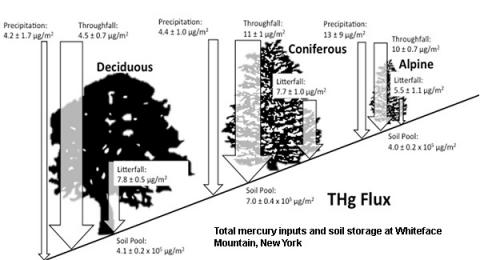Assessing Biological Mercury Hotspots in Montane Ecosystems of the Northern Forest

Mercury is a potent neurotoxin that is transported far from emission sources to remote areas. Once deposited into ecosystems, inorganic mercury can form methylmercury which strongly bioaccumulates and biomagnifies across food chains and poses risks for humans and wildlife. Though methylmercury can form in the atmosphere, the majority of methylmercury is formed by sulfate-reducing bacteria in the soil.
NSRC researchers examined cloudwater, precipitation, litter, and soil samples collected across an elevational gradient on Whiteface Mountain in the Adirondack region of New York State to determine spatial patterns in methylmercury concentrations across a forested montane landscape. Stable mercury isotopes were also measured to trace mercury from atmospheric sources (precipitation and litterfall) to soil and into biota.
Soil methylmercury concentrations were highest in the mid-elevation coniferous zone compared to the high elevation alpine zone and low elevation deciduous zone, while the percent of total mercury as methylmercury in soils decreased linearly with elevation. The elevation pattern of methylmercury concentrations in soil was consistent with mercury concentrations in thrush (bird) species. Patterns of stable mercury isotopes suggest that methylmercury accumulating in terrestrial biota is disproportionately derived from precipitation (rather than litterfall) mercury inputs. These findings suggest that future declines in both local-regional and global mercury emissions that reduce mercury inputs to terrestrial systems could be effective in driving decreases in concentrations of mercury in montane avian species of the Northern Forest.
